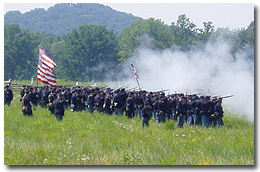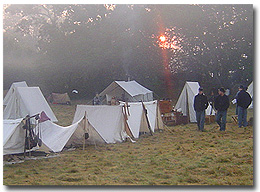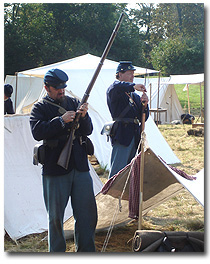Civil War Reenacting
 o
you consider yourself a student of the American Civil War? Have you
ever felt a desire to somehow travel back in time, or tried to imagine
what it would be like to actually be there and experience it all
first-hand?
o
you consider yourself a student of the American Civil War? Have you
ever felt a desire to somehow travel back in time, or tried to imagine
what it would be like to actually be there and experience it all
first-hand?
 If your answer is "yes," then you already
have the most
important trait of a good reenactor. Now, you simply need to acquire
the proper uniform and equipment, learn the drill, and immerse yourself
in living the life of a common soldier. All of these are attainable for
a modest investment of time and money.
If your answer is "yes," then you already
have the most
important trait of a good reenactor. Now, you simply need to acquire
the proper uniform and equipment, learn the drill, and immerse yourself
in living the life of a common soldier. All of these are attainable for
a modest investment of time and money.
Civil War living historians offer many
reasons for doing what
they do; reasons nearly as numerous as the 40,000 Americans who
participate in reenactments. Many pursue that elusive moment of psuedo
time travel when:
- Blinded by drifting clouds of gunsmoke and
deafened by the
thunder of cannon, they suddenly catch a glimpse of the enemy's line
ahead, rifles aimed and ready, and suddenly feel genuine alarm.
- The column of fours they
are marching in extends not only 50 yards in front of them, but 300
yards behind; just like the other column that is marching parallel to
theirs.
- Reveille at 5:00 a.m. and that first sip of
oily campfire
coffee from a tarnished tin cup are events they anticipate and savor
rather than dread and curse.
 Others take pleasure in the brief respite
provided by an
atmosphere free of laptops and smart phones; of nights when the only
light available comes from the living glow of campfires and candles
instead of a hi-def TV screen. They enjoy the unique camaraderie found
at the end of the company street.
Others take pleasure in the brief respite
provided by an
atmosphere free of laptops and smart phones; of nights when the only
light available comes from the living glow of campfires and candles
instead of a hi-def TV screen. They enjoy the unique camaraderie found
at the end of the company street.
A good reenactor is much more than a weekend
warrior dressed
in a properly made wool uniform and loaded down with all kinds of
equipment, sweating it out in 90 degree heat surrounded by hundreds of
others similarly attired. A good reenactor has a mysterious longing to
come as close to possible to the experiences, feelings, joys and
sorrows of those who served in Civil War armies.
What is lovingly referred to as the hobby
appeals to the
amateur historian in all of us, for there is no better way to study and
appreciate history than to live it. But just as important is the task
of keeping this history alive for others rather than allowing it to be
consigned to the dusty shelves of libraries. Reenactors
bring Civil War times back to life at three major types of events:
- Battle
Reenactments are scripted
recreations of
actual Civil War engagements and normally open to admission-paying
spectators. The positions and movements of Union and Confederate troops
mirror, as much as numbers and terrain allow, the original battles.
Since they are taken from history, outcomes are known in advance, but
opposing commanders meet before the first shots are fired to coordinate
movements. Still, there is always an element of uncertainty;
communication under fire is difficult and orders can be misunderstood.
Reenactments can vary greatly in size, with New England events
typically drawing between 100 and 500 soldiers, and larger national
events attracting thousands.
- Living
History Events such as
encampments, parades and
school programs can seem rather mundane and are sometimes referred to
as "Civil War petting zoos," but offer great opportunities to share
knowledge and skills with people who might otherwise not understand or
appreciate the sacrifices that volunteer soldiers endured for their
country. Living history events also help units recruit new members and
raise money for historic preservation. In fact, marches to raise money
for efforts to protect Civil War battlefields from development are an
increasing focus of many living historians.
- Tacticals
are unscripted battles, generally not open
to spectators, that challenge reenactors to use their training to
outwit the opposing army. The objective is to maneuver for position or
achieve some stated goal. On a larger scale, with several hundred
soldiers involved, there can be considerable uncertainty and excitement
as units seek to take bridges, ford streams under fire, or slip around
enemy flanks in dense woods. Tacticals separate the best-drilled
companies and battalions from the rest.
 Fair warning: reenacting is addictive and
will change your
life. You will begin to read history from an entirely different
perspective; that of the private soldier who has shouldered a rifle and
slept on the ground.
Fair warning: reenacting is addictive and
will change your
life. You will begin to read history from an entirely different
perspective; that of the private soldier who has shouldered a rifle and
slept on the ground.
At its worst, Civil War reenacting can be
just about the most
uncomfortable activity imaginable. Yet you will find yourself
anticipating the next event as you travel home from the one you just
attended. You will come to enjoy the pungent aroma of wet wool, and, if
you are willing to let it happen, experience some of the magic of time
travel that living history offers. It only gets better with each
passing year.
One thing upon which most reenactors agree
is that
ultimately, the Civil War was the baptism of one nation by the blood of
two. Without the tragedy of this conflict, there would be no United
States, nor any of what this great nation has since come to stand for.
God Save the Union!


